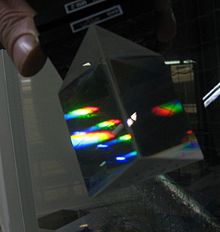- Dispersive prism
-
In optics, a dispersive prism is a type of optical prism, normally having the shape of a geometrical triangular prism. It is the most widely-known type of optical prism, although perhaps not the most common in actual use. Triangular prisms are used to disperse light, that is, to break light up into its spectral components (the colors of the rainbow). This dispersion occurs because the angle of refraction is dependent on the refractive index of a certain material which in turn is slightly dependent on the wavelength of light that is travelling through it. This means that different wavelengths of light will travel at different speeds, and so the light will disperse into the colours of the visible spectrum, with longer wavelengths (red, yellow) being refracted less than shorter wavelengths (violet, blue). This effect can also be used to measure the refractive index of the prism's material with high accuracy. In such a measurement, the prism is placed on the central rotary platform of an optical spectrometer with the incident light beam adjusted such that the refracted beam is at minimum deviation. The refractive index can then be computed using the apex angle and the angle of minimum deviation.
A good mathematical description single-prism dispersion is given by Born and Wolf[1] The case of multiple-prism dispersion is treated by Duarte.[2]
Overview
Although the refractive index is dependent on the wavelength in every material, some materials have a much more powerful wavelength dependence (are much more dispersive) than others. Crown glasses such as BK7 have a relatively small dispersion, while flint glasses have a much stronger dispersion (for visible light) and hence are more suitable for use in dispersive prisms. Fused quartz is used in the ultraviolet as normal glasses lose their transparency there.
The top angle of the prism (the upper corner in the accompanying picture) can be chosen to influence the exact dispersion characteristics. However, it is typically chosen such that both the incoming and outgoing light rays hit the surface approximately at the Brewster's angle, so that reflection losses are minimized. An example is the use of this type of prisms in prism compressors for generation of ultrafast laser pulses.
The prism is also seen on the cover of Pink Floyd's The Dark Side of the Moon. The graphic on the album cover shows the ray of light remaining white while passing through the prism and refracting to the entire visible light spectrum only upon leaving the prism. This image is inaccurate because the different wavelength of different colors of light cause them to refract as soon as they enter the prism. The light then creates lights in the designated places.
See also
- Multiple-prism dispersion theory
- Multiple-prism grating laser oscillators
References
- ^ M. Born and E. Wolf, Principles of Optics, 7 ed. (Cambridge University, Cambridge, 1999), pp. 190–193.
- ^ F. J. Duarte, Tunable Laser Optics (Elsevier Academic, New York, 2003).
Categories:- Prisms
Wikimedia Foundation. 2010.


